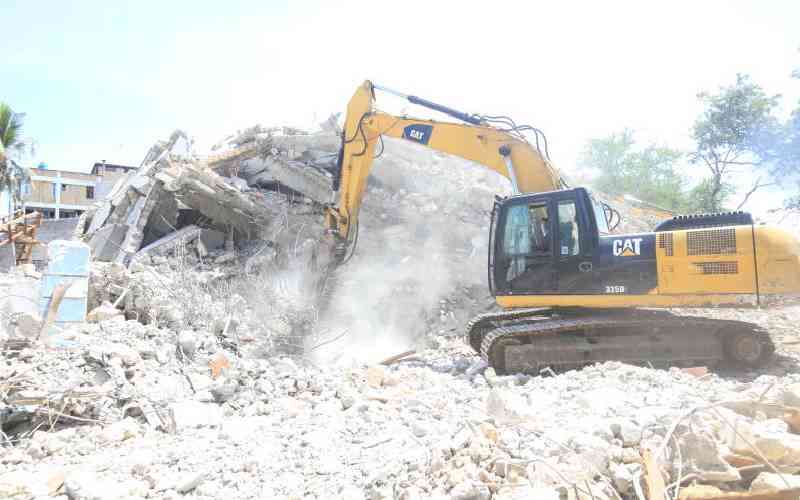The foundation is one of the most expensive elements in building a house and getting it right is a great plus. KEVIN OGUOKO looks at the intricacies around it
Here is no way of going around it; a solid foundation makes a strong house. Arguably the most costly part of a construction, building a foundation requires a lot of skill and expertise.
Many crude experts try to con their way into hundreds of thousands of shillings by using shrewd methods of saving up money for their own gain. The end result is a substandard building prone to collapsing if the foundation cannot hold the weight of the house.
“The foundation affects everything from the wall to the roof of the house. A fragile building foundation will start to show years down the line with walls cracking, roof bending and even the doors refusing to close. It’s the core of a building,” says Michael Ong’any, a private developer in Nyanza.
Building your own house requires one to identify experts in the field with the relevant experience. After the architect has done the initial designing of the house, a quantity surveyor should take over to determine the actual expense that would be required. A civil engineer then takes over the actual construction of the building.
Since quantity surveyors are few, civil engineers often double up as quantifiers and project managers.
Soil influence
Different types of soil determine how deep the foundation should be dug. The two major types of soil in Kenya are the red soils and black cotton soil. While the black cotton soil retains a lot of water, the red soil does not. The retention of water element of black cotton soil is dangerous to the walls of a building’s foundation as it swells up and exerts pressure on the walls. For this reason, the black cotton soil has to be removed completely from the building site when constructing the foundation.
“It is quite expensive in terms of dumping of the soil and digging labour expenses. Many homeowners decide to save cash by digging a shallow foundation site, which is wrong. No building can stand on fragile soil,” says Amos Rotich, a civil engineer and co-owner of Amic Builders Company, a construction firm based in Nairobi.
The black cotton soil is the main type of soil in the Eastlands part of Nairobi, while the easier to work with red soil is found in areas like Kileleshwa and Lavington areas. Many other parts of the country reflect this, with the red soil more common in higher Altitude areas
Regardless, the standard digging range of any building is between 1.2 to 1.5 metres, where the hard rock is found and building of the foundation can start.
The other part of the foundation that determines its strength are the column bases. Column bases are the corner stones of the building and show the outline of the building according to its design.
For this, the right steel reinforcements need to be used to construct the column bases and ones connecting the column bases are needed. Common steel varieties used include Y8, Y10, Y16 and Y20 depending on the structural drawing.
Right steel
“Care has to be taken in the selection of steel these days. There are some in the market, which break when bent, making them hazardous in constructing a house. The standard steel should be able to bend,” says Amos.
Stay informed. Subscribe to our newsletter
The right concrete aggregate need to be used to plaster the column bases together. To ensure this, the right concrete mixture should be used. The standard ratio is 1:2:4 — one bag of cement, two wheelbarrows of sand and four wheelbarrows of ballast — mixed with water to create a concrete.
Thus even when you have a fundi doing the actual construction, one should know some of these basics. Some project managers are commonly known to avoid using the right concrete mixture with the intention of siphoning money or materials.
To curb against this, homeowners can create an independent measure to gauge the diligence of their building contractors. From the Ministry of Public Works, homeowners can acquire what is called a test cube.
The test cube is used to test the strength of the concrete by taking a sample of the wet concrete and taking it to the Ministry of Public Works for testing. The result will show the strength of the concrete and help assure the homeowner of the strength of the concrete as well as keep the contractors in check.
Choosing the stones
Stones used to construct the foundation determine certain elements of the future house.
There are two types of stones commonly used in the market — bush quarry stones, also known as Ngong Quarry stones in Nairobi and its environs, and machine cut stones.
The bush quarry stone is relatively cheaper and the best to use in building the foundation. It meets high strength requirements and it can last for more than 100 years.
Its only disadvantage is the shaping of the stone as it is ragged and requires human labour to shape.
However, its appearance isn’t that important when it comes to foundation as it is covered deep in the ground after the foundation is done.
The machine cut stone is not as strong, but is finely cut and easily attractable, making it preferable for use in building the walls of the house. When used on the foundation of a house, machine cut stones make the house feel quite cold as it absorbs a lot of water from the ground.
Other materials used in construction of a house foundation include BRC mesh size A 142, black polythene sheeting gauge, anti-termite treatment for termites that live in, especially black cotton soil and hard cove/murram for refilling the dug foundation.
 The Standard Group Plc is a
multi-media organization with investments in media platforms spanning newspaper
print operations, television, radio broadcasting, digital and online services. The
Standard Group is recognized as a leading multi-media house in Kenya with a key
influence in matters of national and international interest.
The Standard Group Plc is a
multi-media organization with investments in media platforms spanning newspaper
print operations, television, radio broadcasting, digital and online services. The
Standard Group is recognized as a leading multi-media house in Kenya with a key
influence in matters of national and international interest.
 The Standard Group Plc is a
multi-media organization with investments in media platforms spanning newspaper
print operations, television, radio broadcasting, digital and online services. The
Standard Group is recognized as a leading multi-media house in Kenya with a key
influence in matters of national and international interest.
The Standard Group Plc is a
multi-media organization with investments in media platforms spanning newspaper
print operations, television, radio broadcasting, digital and online services. The
Standard Group is recognized as a leading multi-media house in Kenya with a key
influence in matters of national and international interest.





